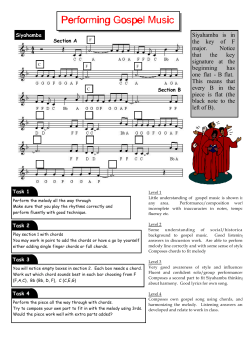
Instrumentation and style
Instrumentation and style Study songs that you admire, especially those that fit the style of your lyrics. For example: ¾¾ Name of song – Barbie Girl ¾¾ Group/artist – Aqua ¾¾ Description of style – girly, pink, bubblegum; dance, happy house, Europop ¾¾ Instruments used – female and male singers, synthesised piano, synthesised strings, synthesised bass, drum machine Instruments or sounds you might use include: singer, backing vocals, electric guitar, acoustic guitar, bass guitar, drum kit, drum machine, synthesiser, samples, piano, Hammond organ, horn section (saxophone, trumpet, trombone), strings (usually a violin section). ¾¾ Tempo – 130 bpm. Composing the song Where you start is often a matter of personal preference. The first thing you write could be a chord progression, a drum pattern, a bass line, a melody for the lyrics or just a short, catchy, melodic idea called a hook. Whichever order you approach, you will probably find yourself changing things the more you get into your piece. So don’t think of your first ideas as being set in stone: you can always change them later. Let’s go through each of these ideas one by one. Harmony V IV V C major I In most styles of pop music, chord progressions tend to be fairly simple, with many songs containing only two or three different chords. A very common feature is a repeated progression of chords, which might last for two or four bars. Here are some examples of some four-chord progressions: C major I VI IV V I §VII VI § VII A minor I III IV V C major Certain styles favour a particular chord progression. Blues-based styles (such as rock ’n’ roll) mostly use chords I, IV and V, as do visceral styles such as punk. Power chords, which contain only two notes a 5th apart, are common in heavy rock and metal. Seventies styles such as funk and prog rock use more complex, jazz-influenced harmonies, often using added notes such as sevenths and ninths. Chart-based pop music often uses standard tonal harmony, as shown in the stock chord progressions in the example above. Step 1 On manuscript or at a computer, invent your own repeated chord progression. Choose a key (such as C major or A minor) and improvise a pattern of chords that works well when repeated. You don’t have to stick to simple triads: you can use seventh chords, pedal notes (such as a tonic pedal) and suspensions. The pattern might have one chord per bar, two chords per bar or maybe two in one and one in the next. This is fine as long as it lasts two or four bars and works well when repeated. Melody Step 2 Now try writing a melody against the four-chord progression you have just written out, setting the lyrics of the first phrase of your verse (if you have used lyrics). The best way to do this is to improvise singing them (or playing on a keyboard) while you, 32 Music Composition Workbook 1 Music Composition Workbook v1.indb 32 17/03/2008 16:42:35
© Copyright 2025





















